Texts nos. 1-19
Browse the RIA 3 Corpus [/riao/ria3/pager/]
1 2 3 4 5 6 7 8 9 10 11 12 13 14 15 16 17 18 19
1
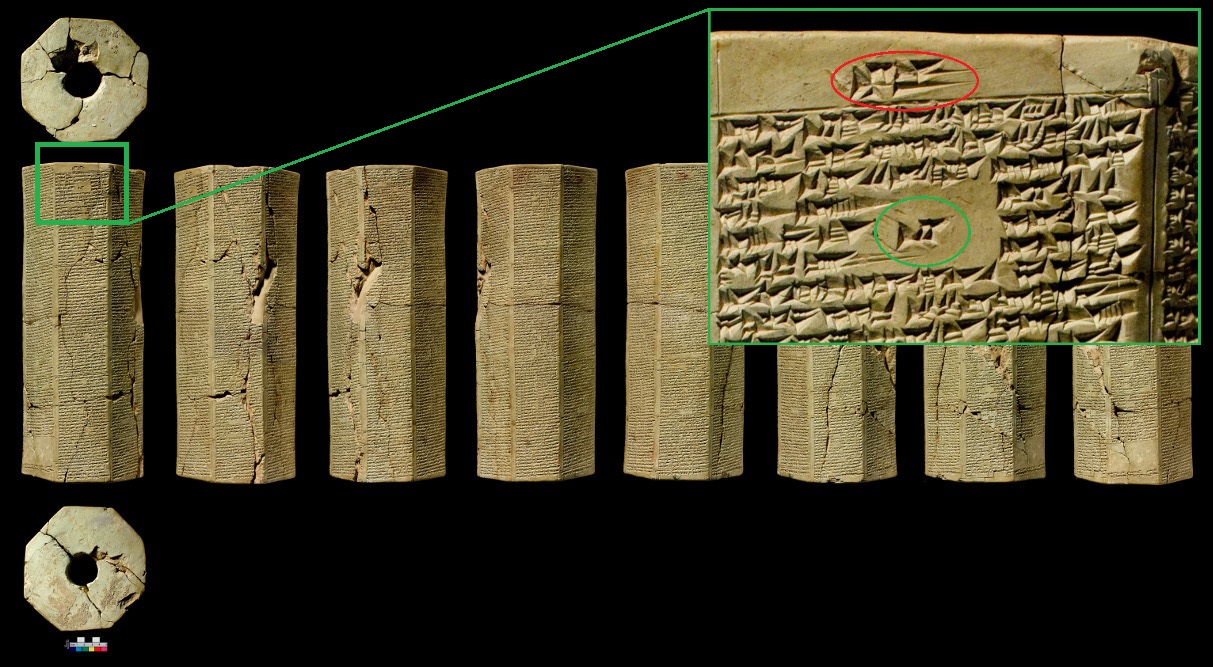
BM 091033 (K 01621a + K 13871 + K
16923) © The
Trustees of the British Museum.
To enlarge the picture to a fully readable size click on this
link [https://cdli.ucla.edu/dl/photo/P393923.jpg] to cdli.
Note, in the red circle, the presence of the Sumerogram SAG (Akk. rēšu "head, beginning") on the top of the first column, and the isolation (green circle), through space management of the first lines, of the Sumerogram EN (Akk. bēlu "lord").
This is the first example of proper Assyrian "annals," (texts nos. 2-4 being later inscriptions) in which military events are recorded in chronological succession, although not yet dated, with epithet formulae and ruling lines clearly dividing one campaign, or regnal year, from the other. This text can be considered as a final stage in the development of this subgenre of royal inscriptions, which starts with the first examples of military accounts in Adad-narari I's inscriptions and further develops with Tukulti-Ninurta I. It is presumable that this text was composed with the help of individual reports, one for each campaign, although none of such text has been found for the period before Ashurnasirpal II (texts nos. 18-20).
This text is inscribed on many octagonal prisms from Ashur (except for exemplar no. 20). This text is also well known for having been the test-case used during the experiment organized by the Royal Asiatic Society of London to test the stage reached with cuneiform decipherment (see Tiglath-pileser I, general Introduction).
Apart from being the first annalistic royal inscription, this text present some of the new motifs that were introduced by Tiglath- pileser and that will become part of the common practice in later reign (see also Tiglath-pileser I, general Introduction).
The beginning of the text (i 1-14) is an invocation to numerous gods, a new motif that is present also (verbatim) in text no. 2, and that will reappear in later inscriptions of Ashur-bel-kala (text no. 7 [/riao/ria3/Q005988/] i 1-11), Adad-narari II (no. 2 [/riao/ria3/Q006021/]: 1-4), Tukulti-Ninurta II (no. 2 [/riao/ria3/Q006032/]: 1-13), Ashurnasirpal II (nos. 8 (according to Grayson, the inscription is not yet published); 17 [/riao/ria4/Q004471/] i 1-10; 19 [/riao/ria4/Q004473/]: 1-4; 20 [/riao/ria4/Q004474/]; 1-13, and 47 [/riao/ria4/Q004501/]: 1-14), and Shalmaneser III (nos. 2 [/riao/ria5/Q004607/] i 1-3; 4 [/riao/ria5/Q004609/]: 1-12; 6 [/riao/ria5/Q004611/] i 1-10; 10 [/riao/ria5/Q004615/] i 1-9; 11 [/riao/ria5/Q004616/]: 1'-7'; 14 [/riao/ria5/Q004619/]: 1-14; 17 [/riao/ria5/Q004622/]: 1-3).
Lines i 51-61 have a detailed description of epithets and capacities of the king, which precedes the core of the text, the military campaigns, which covers lines i 62-vi 54. Lines vi-55-84 has another new motif that will become part of the traditional themes in later inscriptions: the hunt (cf. Ashur-bel-kala texts nos. 1 [/riao/ria3/Q005982/] rev. 7'-11'; 3 [/riao/ria3/Q005984/]: 7'-9'; 7 [/riao/ria3/Q005988/] i 1-33; Ashur-dan II text no. 1 [/riao/ria3/Q006013/]: 68-72; Adad-narari II text no. 2 [/riao/ria3/Q006021/]: 122-127; Tukulti-Ninurta II text no. 5 [/riao/ria3/Q006035/]: 134-135; Ashurnasirpal II texts nos. 1 [/riao/ria4/Q004455/] iii 48-49; 2 [/riao/ria4/Q004456/]: 31-37; 30 [/riao/ria4/Q004456/]: 84-101; cf. also with the iconographic motif of the royal hunt in the reliefs of Ashurnasirpal II and Ashurbanipal [https://www.youtube.com/watch?v=J5iEY4hapMQ]).
Another new motif is the description of the king's concern for the reconstruction and prosperity of his land and people, which appears on lines vi 85-vii 35 of the text. Compare, for example, Ashurnasirpal II texts nos. 28 [/riao/ria3/Q004482/] v 7-12; 29 [/riao/ria3/Q004483/]: 9'17'; 30 [/riao/ria3/Q004456/]: 53-77, in which the work on temples and palaces at Kalḫu reminds Tiglath-pileser's description on works on temples at Ashur. Cf. also the record on the construction works throughout the land in Ashur-dan II text no. 1 [/riao/ria3/Q006013/]: 60-64, Adad-narari II text no. 2 [/riao/ria3/Q006021/]: 120, Tukulti-Ninurta II text no. 5 [/riao/ria3/Q006035/]: 132, ; Ashurnasirpal II text no. 30 [/riao/ria4/Q004456/]: 78-83); the ploughing of fields in Ashur-dan II text no. 1 [/riao/ria3/Q006013/]: 64-67, Adad-narari II text no. 2 [/riao/ria3/Q006021/]: 120-121, Tukulti-Ninurta II text no. 5 [/riao/ria3/Q006035/]: 132-133; the gathering of flocks and herds of wild beasts in Ashur-bel-kala (text no. 7 [/riao/ria3/Q005988/] iv 1-33, Adad-narari II text no. 2 [/riao/ria3/Q006021/]: 122-127, Ashurnasirpal II texts nos. 2 [/riao/ria4/Q004456/]: 31-37, and 30 [/riao/ria3/Q004456/]: 84-101; the importation and planting of exotic trees in Ashurnasirpal II text no. 30 [/riao/ria4/Q004456/]: 36-52; the increasing of chariots and horses in Ashur-dan II text no. 1 [/riao/ria3/Q006013/]: 66-67, Adad-narari II text no. 2 [/riao/ria3/Q006021/]: 121, and Tukulti-Ninurta II text no. 5 [/riao/ria3/Q006035/]: 130-131; Tiglath-pileser's passage, then, ends with the adding of lands and people to Assyria, which is to be found in several later inscriptions, like Tukulti-Ninurta II text no. 5 [/riao/ria3/Q006035/]: 133 and Ashurnasirpal II text no. 30 [/riao/ria4/Q004456/]: 100-101.
Lines vii 36-59 have, somehow unexpectedly in comparison with usual inscriptions' structure, the king's genealogy (but see Shalmaneser I text no. 1 [/riao/ria2/Q005789/] and Tukulti-Ninurta I text no. 1 [/riao/ria2/Q005837/])
The building passage (vii 60-viii 49) records the works on the Anu-Adad temple at Ashur, with a brief history of previous works by Tiglath-pileser's ancestors Shamshi-Adad III [/riao/ria1/oldassyrianperiod/belubanidynasty/shamshiadadiii/index.html] and Ashur-dan I [/riao/ria2/ashurdani/index.html].
Access the composite text [/riao/ria3/Q005926/] of Tiglath-pileser I 01.
Bibliography
2

K 02804 (+) K 02815 + 1881-02-04, 0220 © The
Trustees of the British Museum.
To enlarge the picture to a fully readable size click on this
link [https://cdli.ucla.edu/dl/photo/P394684.jpg] to cdli.
Five clay tablet fragments from Ashur and from Nineveh (the exact location remaining unknown for both places) bear this annalistic text, which is different but parallel to other similar inscriptions nos. 11, 3-4, and later than no 1. In none of the exemplars is the building section survived, although in one piece from Nineveh the few preserved parts seem to indicate that the works there described were carried on the same place described in texts nos. 10 and 11.
Access the composite text [/riao/ria3/Q005927/] of Tiglath-pileser I 02.
Bibliography
3
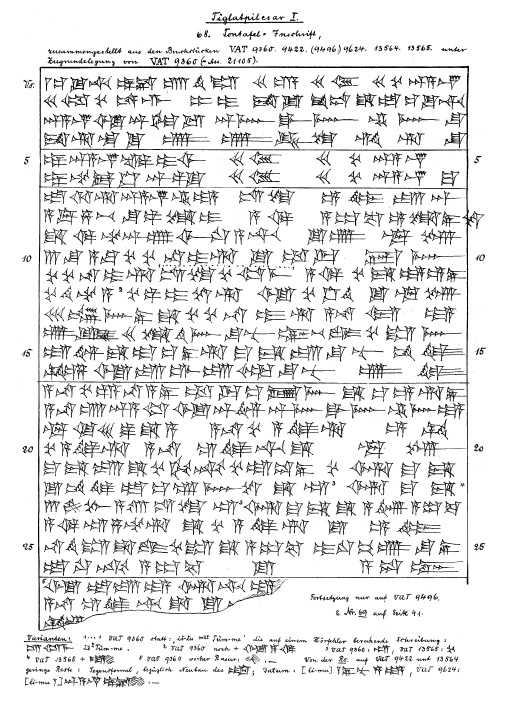
KAH 2 no. 68
Several clay tablets from Ashur bear a text of annalistic type, similar to texts no. 2 and 4. This version of the annals contains campaigns that occurred after those described in texts nos. 1 and 2, and is therefore dated to a later period. The building section records works on the wall of Ashur.
Access the composite text [/riao/ria3/Q005928/] of Tiglath-pileser I 03.
Bibliography
4
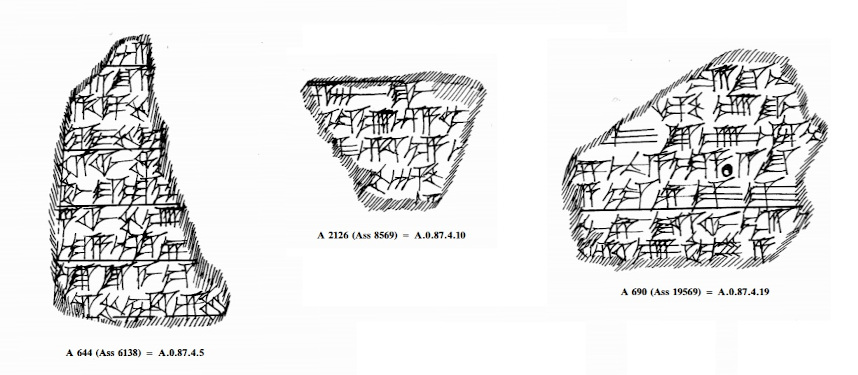
Donbaz, ARRIM 8 p. 3
Numerous exemplars from Ashur (many clay tablet fragments, three stone tablets, one clay prism fragment) bear the following inscriptions, which includes a summary of Tiglath-pileser's campaigns, with the first record of the conquest of Babylonia (lines 37-40 and 44-51) – which makes the text later than nos. 1-3 – and with a very peculiar building section. Lines 52-66 (cf. text no. 7 v 4-6) describes the work on the" house of the šaḫūru" and the "house of the labūnu"; the next passage (lines 67-71) describes the crafting of animal figurines and their setting at the entrance of the palace (cf. text no. 17, but also Ashur-bel-kala text no. 11). Then a record is given on the construction of a "palace of weapons" beside the palace (lines 72-76; cf. text no. 8 and 29), and (lines 77-89) of a "cedar palace," called Egallugalšarrakurkurra (cf. text no. 7).
The text is known for being of great difficulty, for which see RIMA 2, p. 40 with previous bibliography.
Access the composite text [/riao/ria3/Q005929/] of Tiglath-pileser I 04.
Bibliography
5
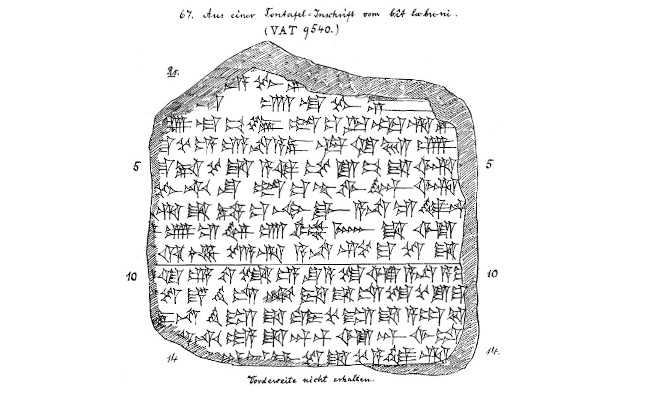
KAH 2 no. 67
Only part of the reverse is preserved from this text on clay tablet, which is very similar to text no. 4, although not identical. The survived part contains a building section describing the works on the palace of Ashur. Like the building passage of text no. 4, this text is written in Assyrian dialect.
Access the composite text [/riao/ria3/Q005930/] of Tiglath-pileser I 05.
Bibliography
6
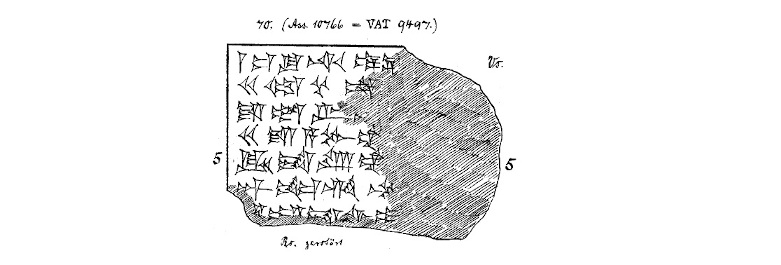
KAH 2 no. 70
A small fragment of a clay tablet from the city area of Ashur bears the beginning of a Tiglath-pileser's inscription which clearly differs – although so little of it is preserved – from the other edited here.
Access the composite text [/riao/ria3/Q005931/] of Tiglath-pileser I 06.
Bibliography
7

Donbaz, ARRIM 8 p. 3
A small piece of a clay tablet (4.9 × 4+ cm) discovered at Ashur (no specific provenance known) is inscribed with an inscription of Tiglath-pileser I recording his conquest of Babylon; the campaign is described in a different manner from those included in text nos. 4 [/riao/ria3/Q005929/] (lines 46-51) and 10 [/riao/ria3/Q005935/] (lines 47-53).
Although the tablet is very fragmentary, an identification with Tiglath-pileser I is supported by parallels between the aforementioned texts, by the distinctive forms of the signs (the "Tiglath pileser I" script), and by the texture of clay, typical of this suzerain's reign, which consists of an ivory white centre covered with a red slip (see introduction to this reign).
Access the composite text [/riao/ria3/Q005932/] of Tiglath-pileser I 07.
Bibliography
8
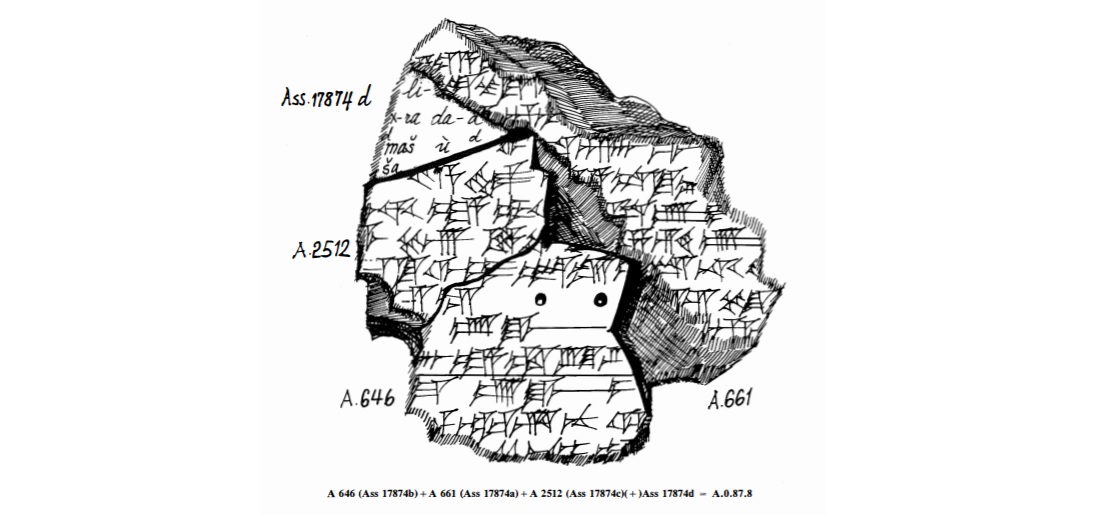
ARRIM 8 p. 4
This text has been reconstructed joining together different clay tablet fragments found at Ashur (specific provenance unknown). The remaining inscription records the creation of animal figurines (cf. text no. 4) and of other decorative elements of the palace.
Access the composite text [/riao/ria3/Q005933/] of Tiglath-pileser I 08.
Bibliography
9

KAH 2 no. 72
A clay tablet from the city area of Ashur bears what is presumably a Tiglath-pileser's inscription; the presence of the toponym Adauš, attested almost exclusively in the inscriptions of this king, remains the strongest indicator in such sense.
Access the composite text [/riao/ria3/Q005934/] of Tiglath-pileser I 09.
Bibliography
10

Sm 1874 © The
Trustees of the British Museum.
To enlarge the picture to a fully readable size click on this
link [https://cdli.ucla.edu/dl/photo/P426152.jpg] to cdli.
Clay tablets from Nineveh are inscribed with this text, which has an introduction very similar to the one in text no. 4, followed by the record of works carried out at the city wall of Nineveh and on a garden and canal in the city, as well as a palace beside the Ištar temple.
Access the composite text [/riao/ria3/Q005935/] of Tiglath-pileser I 10.
Bibliography
11
This text has an introduction identical to text no. 10, followed by a building section concerning works on a palace at Nineveh (possibly the same one described in text no. 10), where the broken tablet on which this text is inscribed was discovered.
Access the composite text [/riao/ria3/Q005936/] of Tiglath-pileser I 11.
Bibliography
12

K 02807 © The
Trustees of the British Museum.
To enlarge the picture to a fully readable size click on this
link [https://cdli.ucla.edu/dl/photo/P394687.jpg] to cdli.
Two clay tablet fragments from Nineveh bear a broken text describing some military campaigns otherwise unknown, and some works on the Ištar temple, with a brief mention of previous works on the same building – including Samsi-Addu I [/riao/ria1/oldassyrianperiod/samsiaddudynasty/samsiaddui/index.html], Ashur-uballit I [/riao//ria1/kingdomofassyria/ashuruballiti/index.html], and Shalmaneser I [/riao/ria2/shalmaneseri/index.html].
Access the composite text [/riao/ria3/Q005937/] of Tiglath-pileser I 12.
Bibliography
13

BM 122630 © The
Trustees of the British Museum.
To enlarge the picture to a fully readable size click on this
link [https://cdli.ucla.edu/dl/photo/P422414.jpg] to cdli.
A clay tablet fragment from Nineveh bears a broken inscription with the description of three campaigns, all of which are slightly different version of the same accounts in other texts.
Access the composite text [/riao/ria3/Q005938/] of Tiglath-pileser I 13.
Bibliography
14
A piece of stone octagonal prism (13.5 × 8.3 cm) discovered at Nineveh and containing a fragmentary text. The prism bears the name of Tiglath-pileser, although it is unclear to which particular king of that name it refers. As such, identification with Tiglath-pileser I is not certain. As it is currently not possible to locate the fragment, one must rely on Thompson's edition, who gives its provenance at the Ishtar temple as Q.O.
Access the composite text [/riao/ria3/Q005939/] of Tiglath-pileser I 14.
Bibliography
15

Elaboration from: Entrance of the Tigris tunnel, Shalmaneser III's Balawat Gates (see this ruler's text (no. 63-64 [/riao/ria5/shalmaneseriii/texts6386/index.html#shalmaneser363]), and portrait of Tiglath-pileser I: King, Bronze reliefs (1915) pl. 54-9, and Börker-Klähn, Bildstelen no. 149.
At the source of Tigris, in the point where the river Subnat emerges from the tunnel, one finds a rock relief of Tiglath-pileser I, flanked by one engraved a couple of hundreds of years later by Shalmaneser III (text no. 21 [/riao/ria5/shalmaneseriii/texts2039/index.html#shalmaneser321]). The inscription commemorates the success of the third campaign against the Land of Nairi.
Access the composite text [/riao/ria3/Q005940/] of Tiglath-pileser I 15.
Bibliography
16
A rock face at Yoncali, in the Melazzert region, north of Lake Van, the core of the Land of Nairi, commemorates a successful campaign in the region and in Ḫabḫu.
Access the composite text [/riao/ria3/Q005941/] of Tiglath-pileser I 16.
Bibliography
17
Although the current location of the group of texts nos. 17, 18, 19 and 20 is unknown, they were discovered at the entrance to Tiglath-pileser I's palace in 1905 (according to Andrae). They are some of the many stone fragments of small sculptures and slabs, which bore inscriptions containing the name of that monarch that Andrae reportedly found there. As such, they could well be the exotic creatures that Tiglath-pileser's texts describe being set up at the entrance of the palace (see introduction to text no. 4).
Andrae claimed to have identified four separate texts from these various fragments, although he only gives a description and translation of one of them. From this, Weidner created a hypothetical transliteration of the inscription which was then used by Grayson and is presented here. It is important to bear in mind that this reconstruction is very uncertain, both in terms of form and detail. The remaining fragments are then grouped together as texts nos. 18-20.
Access the composite text [/riao/ria3/Q005942/] of Tiglath-pileser I 17.
Bibliography
18
As explained in the introduction to text no. 17, Andrae identified four distinct texts on the many fragments of inscribed stone that were discovered in 1905 near the entrance to the palace of Tiglath-pileser I at Ashur. Text no. 17 [/riao/ria3/Q005942/] represents one of these and the rest are discussed here, although no edition will be given as the objects were not available for study and -- unlike text no. 17 -- none of them were ever published. Therefore all that is possible is briefly to summarise Andrae's comments. One of the texts has [Aššur-S]AG-i-ši written in the third line. A second text was only two lines long and reportedly referred to the "Cedar Palace", and the third had in the last line NA4.AD.BAR DÙ(?)-uš ina né-r[i-bī] MAN(?)-ti-ia 'I made (replicas in) basalt (... I stationed them on the right and left) of my royal entrance.' Cf. Text no. 4 [/riao/ria3/Q005929/] lines 70-71.
Access the composite text [/riao/ria3/Q005943/] of Tiglath-pileser I 18.
Bibliography
19
Please refer to the introduction to text no. 18.
Access the composite text [/riao/ria3/Q005944/] of Tiglath-pileser I 19.
Bibliography
Nathan Morello, Jamie Novotny & Poppy Tushingham
Nathan Morello, Jamie Novotny & Poppy Tushingham, 'Texts nos. 1-19', RIA 3: Inscriptions of Tiglath-pileser I to Tukultī-Ninurta II, The RIA Project, 2023 [http://oracc.org/tiglathpileseri/texts119/]